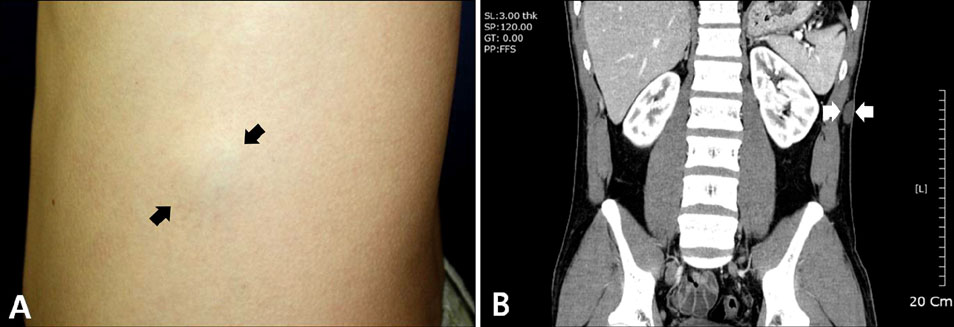Ann Dermatol.
2011 Aug;23(3):338-341. 10.5021/ad.2011.23.3.338.
Subcutaneous Myxoid and Round Cell Liposarcoma
- Affiliations
-
- 1Department of Dermatology, Hanyang University College of Medicine, Seoul, Korea. drko0303@hanyang.ac.kr
- 2Department of Pathology, Hanyang University College of Medicine, Seoul, Korea.
- KMID: 2171925
- DOI: http://doi.org/10.5021/ad.2011.23.3.338
Abstract
- Myxoid and round cell liposarcoma is a variant of liposarcoma characterized by a morphologic continuum in which tumor progression from low-grade myxoid to high-grade hypercellular or round cell areas may be observed. A 28-year old man presented with a painful skin colored subcutaneous mass on his left flank. The skin lesion was discovered about two months ago. Computed tomography revealed a well-defined tumor in the subcutaneous area without significant lymphadenopathy. A histopathologic study showed a nonencapsulated nodular growing tumor mass under the deep dermis composed of a mixture of atypical proliferating lipoblasts in a prominent myxoid stroma, occasional uniform round to oval shaped primitive nonlipogenic mesenchymal cells and plexiform, chicken wire shaped capillaries. Based on these findings, we diagnosed this case as myxoid and round cell liposarcoma. Because liposarcomas are large tumors of the deep subcutis or deeper soft tissue, they rarely come to the attention of the dermatologist. However, liposarcoma should be of concern, especially when rapid growing subcutaneous tumors are shown.
Keyword
Figure
Reference
-
1. Spanier SS, Floyd J. A clinicopathologic comparison of malignant fibrous histiocytoma and liposarcoma. Instr Course Lect. 1989. 38:407–417.2. Tallini G, Akerman M, Dal Cin P, De Wever I, Fletcher CD, Mandahl N, et al. Combined morphologic and karyotypic study of 28 myxoid liposarcomas. Implications for a revised morphologic typing, (a report from the CHAMP Group). Am J Surg Pathol. 1996. 20:1047–1055.3. Dei Tos AP, Mentzel T, Fletcher CD. Primary liposarcoma of the skin: a rare neoplasm with unusual high grade features. Am J Dermatopathol. 1998. 20:332–338.
Article4. Dei Tos AP. Liposarcoma: new entities and evolving concepts. Ann Diagn Pathol. 2000. 4:252–266.
Article5. Newlands SD, Divi V, Stewart CM. Mixed myxoid/round cell liposarcoma of the scalp. Am J Otolaryngol. 2003. 24:121–127.
Article6. Orvieto E, Furlanetto A, Laurino L, Dei Tos AP. Myxoid and round cell liposarcoma: a spectrum of myxoid adipocytic neoplasia. Semin Diagn Pathol. 2001. 18:267–273.7. Smith TA, Easley KA, Goldblum JR. Myxoid/round cell liposarcoma of the extremities. A clinicopathologic study of 29 cases with particular attention to extent of round cell liposarcoma. Am J Surg Pathol. 1996. 20:171–180.8. Graadt van Roggen JF, Hogendoorn PC, Fletcher CD. Myxoid tumours of soft tissue. Histopathology. 1999. 35:291–312.
Article9. Kilpatrick SE, Doyon J, Choong PF, Sim FH, Nascimento AG. The clinicopathologic spectrum of myxoid and round cell liposarcoma. A study of 95 cases. Cancer. 1996. 77:1450–1458.
Article10. Antonescu CR, Tschernyavsky SJ, Decuseara R, Leung DH, Woodruff JM, Brennan MF, et al. Prognostic impact of P53 status, TLS-CHOP fusion transcript structure, and histological grade in myxoid liposarcoma: a molecular and clinicopathologic study of 82 cases. Clin Cancer Res. 2001. 7:3977–3987.11. Thomas DH, Jose MM, Anthony JM, Stuart JS, Jean-hilaire S. Dermatology. 2003. 1st ed. London: Mosby;1895–1896.12. Dalal KM, Antonescu CR, Singer S. Diagnosis and management of lipomatous tumors. J Surg Oncol. 2008. 97:298–313.
Article13. Kim TH, Kim JW, Kim SW, Kim DS, Ahn KY. Myxoid liposarcoma. Ann Dermatol. 1996. 8:144–148.
Article14. Kim WH, Seung NR, Kim CW, Cho HJ, Kim KH, Kim KJ. A case of well-differentiated liposarcoma. Ann Dermatol. 2006. 18:105–108.
Article15. Moon JW, Na CH, Seo HD, Choi KC, Shin BS. A case of myxoid liposarcoma. Korean J Dermatol. 2008. 46:1629–1633.16. Byun JY, Choi YW, Choi HY, Myung KB. A case of dedifferentiated liposarcoma that developed in the dermis. Ann Dermatol. 2008. 20:204–208.
Article



